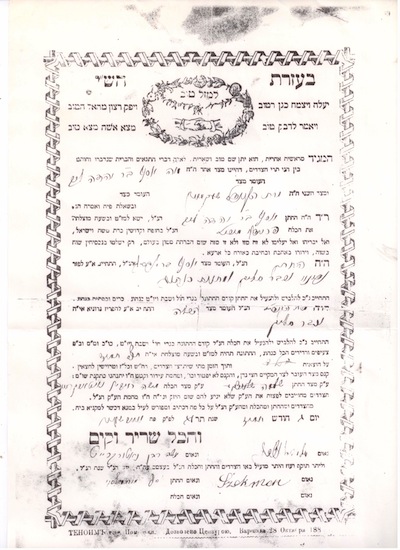On Oct. 31, among the ruins of Kibbutz Be’eri, Israel Defence Forces personnel brief a delegation of Conservative rabbis and lay leaders from the United States, Canada and Britain, which was on a three-day solidarity mission organized by the Fuchsberg Jerusalem Centre. (photo by Boaz Pearlstein)
WARNING: Extremely graphic reporting.
Since Hamas’s Oct. 7 cross-border assault on multiple army bases, kibbutzim, cities and a music festival in the Gaza Strip periphery, staff at the Israel Defence Forces’ Shura base have been working around the clock to identify the remains of the 1,100 civilians and 315 IDF soldiers, reservists and police officers massacred by jihadi terrorists. With so many bodies, the victims were initially kept in refrigerated milk trucks in the morgue’s parking lot. Plain wooden coffins are stacked in the corridors, waiting for a positive identification so the remains may be released to their families for burial at a military or civilian cemetery. Only then can Judaism’s seven-day period of mourning begin.
A month on, the sickly smell of death lingers. Pathologists at this normally quiet IDF logistics centre and home base of the military rabbinate corps – located on the outskirts of Ramla, a mixed Jewish-Arab city not far from Ben-Gurion Airport – continue their painstaking, harrowing but holy forensic mission.
Dismembered limbs and badly decomposed bodies continue to be delivered. The human remains are sniffed out under the rubble of destroyed buildings by IDF canine units, staff told a 33-person Oct. 31 delegation of Conservative rabbis and lay leaders from the United States, Canada and Britain.
Initially, it is often impossible to determine if the remains are those of victims or perpetrators, Col. Rabbi Haim Weisberg, head of the IDF’s rabbinic division, told the religious leaders. Many are mutilated with limbs and heads dismembered, making the ghoulish jigsaw puzzle even more complex.
“We are in an abnormal situation and that is why it is taking so much time to identify the bodies. In most cases, we have had to identify people via deep tissue DNA or dental records because there is nothing left,” he explained.
The complex identification process has been compounded because so many of the victims were not Israeli residents.
Pathologists can take several hours to assess a body, photograph it and document the fatal wounds. Out of respect for the dead and their families, the IDF is not releasing those photos.
Weisberg spoke not only about whole bodies but also about charred and incomplete remains, including what in one case turned out to be a corpse so severely burned that only a CT scan revealed it was a mother and baby bound together in a final embrace.
The grisly job is complicated by uncertainty over the tally of victims. According to constantly updated data from the IDF, more than 1,400 Israelis and foreigners were murdered. Some 238 people are believed to be held hostage by Hamas inside the Gaza Strip and the fate of dozens of others is unknown. Some may be held inside Gaza by other terrorist groups, like Palestinian Islamic Jihad, or even by individuals. Others may still be among the dead, yet to be identified by the staff at Shura.
When drafted, all IDF recruits provide samples of their DNA and fingerprints, and have their teeth X-rayed. The army does not rely exclusively on identification made through a soldier’s twin dog tags kept in their combat boots and worn on a chain around the neck.
According to halachah (Jewish law), fallen soldiers are buried in a coffin in their blood-soaked uniform. They are not ritually washed in the tahara ceremony – the Jewish tradition of purification of the dead – nor are they wrapped in shrouds. The intention is that God should be angered by witnessing the fallen defenders among his Chosen People. Personal effects like a cellphone, watch or wallet are washed of blood and then returned to the family of the deceased. Artifacts that cannot be cleansed of blood are buried with the deceased.
By contrast, civilian dead are ritually washed and wrapped in shrouds. Generally, in Israel, they are interred directly in the ground without a coffin.
While dental records can allow straightforward identification of dead soldiers, that information is often unavailable for civilians. Many dental offices in the city of Sderot near Gaza were destroyed, and with them their files.
Ritual washing is tasked to male and female reservists who have volunteered for the mitzvah (commandment) of chesed shel emet (true kindness).
Women soldiers perform tahara for the hundreds of girls and women who were murdered. The team is working in shifts around the clock. Among them is Shari, an architect living in Jerusalem whose surname may not be released under IDF security regulations. She volunteered for the unit when it was established more than a decade ago to ensure that the modesty of female recruits killed in action was protected.
“We saw evidence of rape … and this was also among grandmothers down to small children,” she stated.
Shari said she and the other volunteers received specialized training from the IDF, which prepared them practically and mentally to care for the bodies of the dead. Until Oct. 7, she had not been called for active duty.
“I’ve seen things with my own eyes that no one should ever see,” she said, describing how she took care of the dead women. Many were still dressed in their pajamas. Their bodies had been booby-trapped with grenades, and the remains bore evidence of extreme brutality.
Shari’s duties begin with opening the body bags to remove the dead person’s clothes, jewelry and any other personal possessions in order to return them to the families.
“The only colour among the blood and dirt was their nails, beautiful manicures, painted the brightest colours,” Shari said, adding, “Their nails made me weep.”
“We gathered this group of 33 Jewish communal leaders from across North America to witness the horrors our brothers and sisters have suffered,” said Dr. Stephen Daniel Arnoff, chief executive officer of the Fuchsberg Jerusalem Centre – a home for Conservative and Masorti Judaism in Israel, which organized the three-day solidarity mission. Located in Jerusalem, the centre offers opportunities to study, pray and explore within an egalitarian and inclusive setting, creating multiple pathways for finding personal and communal meaning.
The solidarity group included the first civilians to tour the devastated remains of Kibbutz Be’eri, where terrorists went house to house slaughtering the inhabitants. Wearing flak vests and helmets, the clergy and communal leaders recited the El Male Rachamim and Kaddish prayers for the dead as soldiers continued their search for human remains.
“We literally saw the blood of our people crying out to us from the ground,” said Arnoff.
“It is our moral obligation to make sure that the world knows what happened there.”
Gil Zohar is a writer and tour guide in Jerusalem.




